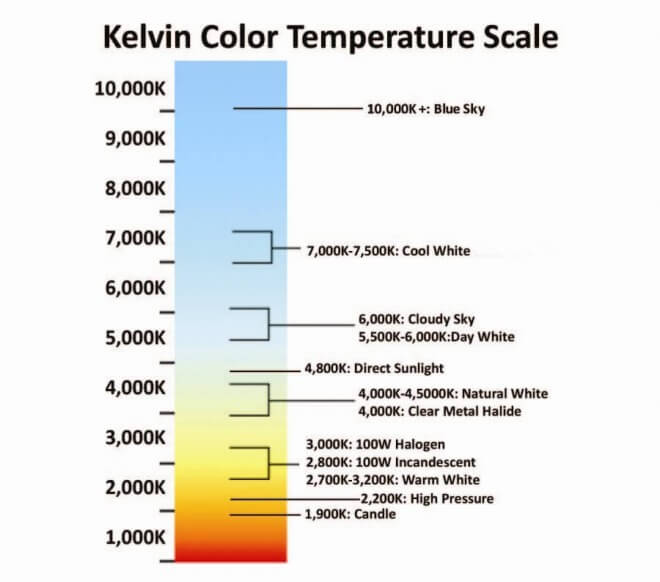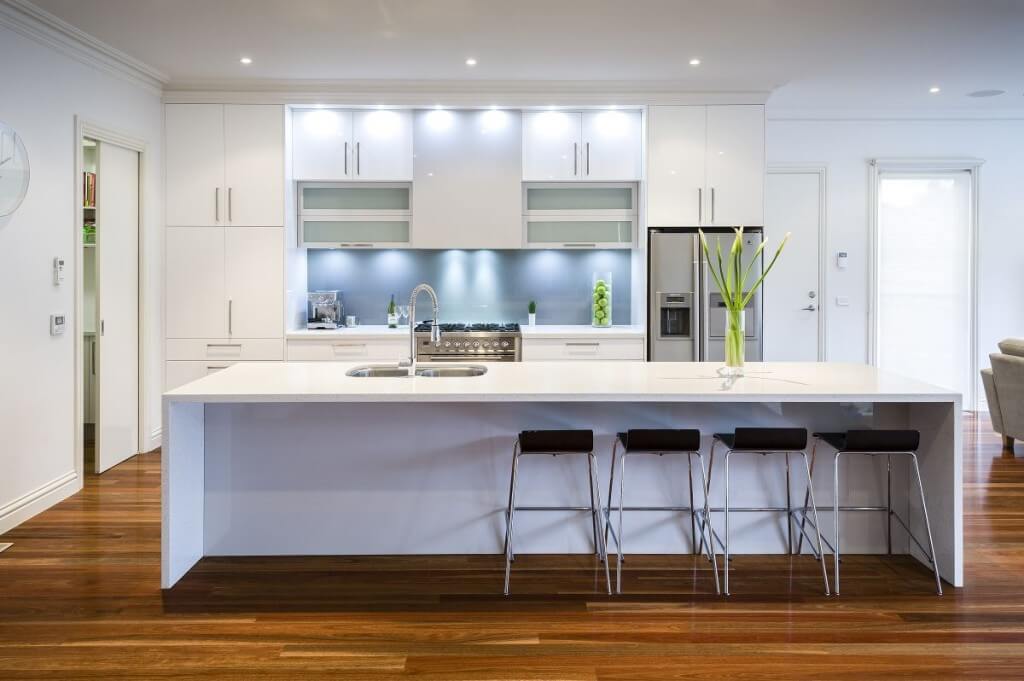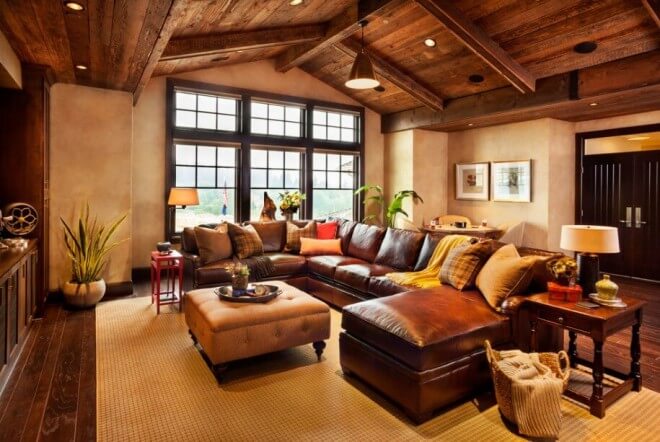
Anyone who has ever shopped for an LED light bulb or purchased LED strip lights has probably heard terms like cool white, warm white, or natural white. If you’ve really done your research, you might have noticed that these terms are also attached to a scale of numbers called the Kelvin Color Temperature. This color temperature scale ranges from 1,700 K to 27,000 K and looks like the chart below. So what does the chart below mean and how does that number associate with the set of LED light bulbs you want to purchase?
This information will give insight into what color temperature is in lighting and how to apply it.
The Origin of the Kelvin Color Temperature Scale (If You Want to Geek Out)
Up until the invention of LED lighting, temperature was directly related to the type of color a light source would produce. Every man-made light source besides LED lighting required the production of heat in order to make light. If you remember from your high school science class, Kelvin is a unit measure of temperature (reminder: it was usually attached to how hot the sun was or some distant star).
A Kelvin color temperature scale works something like this: if you were to stand next to and look at a torch flame, you could feel its heat and see that it gives off a very intense blue light. In contrast, if you were to stand next to and look at a candle, you would see it gives off very little heat and produces a less intense yellow light. So that’s why a light bulb with a color temperature of 7,000K has a blue hue versus a 2,700K light bulb with more of an orange hue.
Helpful hint: Cool white and warm white does not directly relate to the actual Kelvin light scale. “Cool” refers to the icy blue hue that a higher color temperature produces and “warm” refers to the candlelight-yellow hue a lower color temperature produces.

Applications of Color Temperature
Color temperature is more of a color preference than a way to measure the brightness or quality of the light. However, a few characteristics of certain color temperatures may impact your preference.
Let’s go over a few questions that will help you choose a color temperature and determine your preferences.
Where Is the Light Going?
Are you looking to place this light in a living room, hallway, kitchen, or bedroom? The lightbulb’s placement may determine what color temperature you choose.
A lower color temperature or warmer light (2,700K- 3,000K) is less intense to our eyes, making this range the best color temperature for bathrooms, living rooms, family rooms, or bedrooms, where we want to promote relaxation. Research indicates that cooler, bluer light can disrupt the production of melatonin, a hormone that helps regulate sleep.
A higher color temperature or cooler light (5,500K-6,000K) is more intense and often works best in an office space, study room, or kitchen light color temperature. For spaces where you perform tasks like reading, cooking, or studying, a cooler color temperature is ideal as it provides brighter illumination and can reduce eye strain.
If you’re placing a light outdoors, the more intense cool white light may offend neighbors and confuse wildlife. However, you may also more easily get the attention of an onlooker with a cooler white. Warmer color temperatures are common in landscape lighting to create a relaxing, comfortable environment, while you might prefer cooler temperatures for security lights.
If you need lighting for horticulture, consider that certain indoor gardening systems use specific color temperatures to stimulate plant growth. Cooler color temperatures are typically used to promote vegetative growth, while warmer color temperatures are beneficial during the flowering stage.

What to Consider
It’s also helpful to look around your living space and assess the tones of your furnishings and decor items. If you have cooler colors in your space, such as shades of grey, blue, green, and black, cooler lights might complement the area. With warmer earth tones, a lower color temperature will probably provide the look you want.
What Type of Mood Do You Want?
Because warm whites carry a lower frequency than cool whites and are therefore less intense to our eyes, you can often set a cozy and more relaxing mood with a warm white light. If you’re needing to keep a more productive mood in the area you are lighting a cool white which has a higher frequency and is more intense to our eyes might give an added benefit.
Some common colors associated with the color temperature scale are:
| Match / Candle Flame: | 1500 - 1850K |
| Standard Incandescent: | 2400K |
| Soft White Incandescent: | 2550K |
| Warm White LEDs: | 2900-3200K |
| Pure White LEDs: | 4100-4300K |
| Natural White LEDs: | 4200-4500K |
| Daylight White LEDs: | 5000-5500K |
| Cool White LEDs: | 5500-6000K |
| LED or CRT Sceen: | 6500-9500K |
| Clear Blue Sky: | 15000 - 27000K |

How Do You React to a Certain Color Temperature?
Not everyone responds the same way to certain color temperatures. I don’t like the look of a real warm light (2,700K) because it makes me feel tired and slow. I prefer a natural or even cooler color temperature (4,800K-6,000K) because I feel more energetic and awake. Others feel that cool and natural lights are too bright and hurt their eyes. You’ll have to find out what your response is to different color temperatures and determine which you prefer.
Other Measurements of Light
If you’re trying to determine what light will work best for your situation, color temperature is not the only measurement to consider. Delivered lumens, wattage, and color rendering index are other measures you’ll want to look into to determine the best light for your needs.
Here is a brief description of each measurement and its function.
Lumens: The amount of visible light a source can produce. It will typically help you to know how bright a bulb will be. In this case, higher is brighter. Helpful Tip: Although many feel cool white lights are brighter than warm white lights, it is more a perception than a reality. Cool white has a higher wavelength frequency and therefore is more intense to our eyes making it appear brighter. However, If you compare a warm and cool white light that delivers the same amount of lumens they will both be as bright as the other, but produce different colors.
Wattage: The amount of watts, or units of power the light requires. This will help you to know how much energy you are consuming with the light you purchased. The higher the wattage used the more energy you consume.
Color Rendering Index (CRI): A measure of quality that helps to reveal a light source’s ability to show colors as they truly are. This measurement is different than color temperature because instead of determining what color the light will produce the CRI will determine how well colors will look under that light. Higher CRI ratings will produce better-quality light.

Need Help Deciding What Light to Buy?
If you have LED fixtures to install, a lighting project you’re working on, or questions about lighting in general, we’d love to help. Leave us a comment, call, or email and we’ll get you what you need. Birddog Lighting has been in the lighting industry for over 20 years and has made it our focus to help you accomplish any lighting project you desire. Whether you are changing out a light bulb or working on a unique lighting masterpiece, our lighting professionals can help you along the way.

